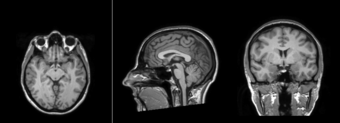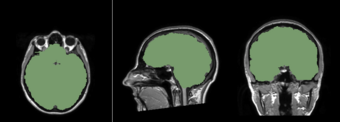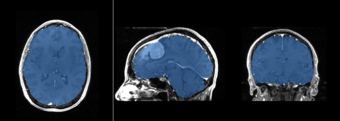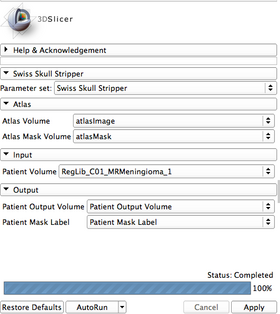Difference between revisions of "Documentation/Nightly/Modules/SwissSkullStripper"
(Created page with '<noinclude>{{documentation/versioncheck}}</noinclude> <!-- ---------------------------- --> {{documentation/{{documentation/version}}/module-header}} <!-- -----------------------…') |
|||
| (6 intermediate revisions by 2 users not shown) | |||
| Line 14: | Line 14: | ||
Contributor1: Stefan Bauer (Institute for Surgical Technology and Biomechanics, University of Bern)<br> | Contributor1: Stefan Bauer (Institute for Surgical Technology and Biomechanics, University of Bern)<br> | ||
Contributor2: Thomas Fejes (Institute for Surgical Technology and Biomechanics, University of Bern)<br> | Contributor2: Thomas Fejes (Institute for Surgical Technology and Biomechanics, University of Bern)<br> | ||
| − | Contributor3: | + | Contributor3: Mauricio Reyes (University of Bern)<br> |
Contributor4: Arnaud Gelas (Crisalix)<br> | Contributor4: Arnaud Gelas (Crisalix)<br> | ||
Contact: Bill Lorensen, <email>bill.lorensen@gmail.com</email><br> | Contact: Bill Lorensen, <email>bill.lorensen@gmail.com</email><br> | ||
| Line 27: | Line 27: | ||
brain extraction based on level-sets. The level-set is evolved towards | brain extraction based on level-sets. The level-set is evolved towards | ||
the edge of the brain-skull border with dedicated expansion, curvature | the edge of the brain-skull border with dedicated expansion, curvature | ||
| − | and advection terms. | + | and advection terms. |
| − | The module produces a brain mask for the patient data as well as the patient data with the | + | |
| − | For the atlas, a customized isotropic T1-weighted MR image and a | + | The module produces a brain mask for the patient data as well as the patient data with the mask applied.<br> |
| − | manually generated brain mask are available for download. | + | For the atlas, a customized isotropic T1-weighted MR image and a manually generated brain mask are available for download. |
| − | |||
| − | |||
Users can also provide their own atlas image and brain mask. | Users can also provide their own atlas image and brain mask. | ||
| + | |||
<!-- ---------------------------- --> | <!-- ---------------------------- --> | ||
{{documentation/{{documentation/version}}/module-section|Use Cases}} | {{documentation/{{documentation/version}}/module-section|Use Cases}} | ||
| Line 52: | Line 51: | ||
|[[Image:SwissSkullStripperPanel.png|thumb|280px|Module UI]] | |[[Image:SwissSkullStripperPanel.png|thumb|280px|Module UI]] | ||
|} | |} | ||
| + | # Load atlas image and atlas brain mask volumes: | ||
| + | #* Option A: Go to ''Sample data'' module, scroll down to ''SwissSkullStripper'' category, and click on ''SwissSkullStripperAtlasImage'' and ''SwissSkullStripperAtlasMask'' images | ||
| + | #* Option B: Use your own atlas image (or [https://github.com/lorensen/SwissSkullStripperExtension/raw/master/SwissSkullStripper/Data/Input/atlasImage.mha download one]) and corresponding atlas brain mask volume (or [https://github.com/lorensen/SwissSkullStripperExtension/raw/master/SwissSkullStripper/Data/Input/atlasMask.mha download one]). '''Important: in ''Add data'' dialog, click ''Show options'' and make sure ''Labelmap'' checkbox is checked for the for the brain mask volume''' (if this step is missed then the mask volume will not appear in the atlas mask volume selector) | ||
| + | # Load a patient volume. Use your own, or ''MRBrainTumor1'' sample data or [https://github.com/lorensen/SwissSkullStripperExtension/raw/master/SwissSkullStripper/Data/Input/RegLib_C01_MRMeningioma_1.nrrd download one]. | ||
| + | # Go to ''Swiss Skull Stripper'' module | ||
| + | # Select ''Patient volume'' (e.g., ''MRBrainTumor1''), ''Atlas volume'' (e.g., ''atlasImage''), ''Atlas mask volume'' (e.g., ''atlasMask'') | ||
| + | # Create new volumes for ''Patient output volume'' and ''Patient mask label'' | ||
| + | # Click Apply. Within about 2 minutes, the module produces: | ||
| + | ## A patient volume that resides within the patient mask | ||
| + | ## A patient brain mask volume | ||
| + | # For better visualization of the patient mask volume, make it displayed as outline only (go to Data module, right-click on the ''eye' icon of patient mask label volume, and check ''Toggle 2D outline visibility'') | ||
| + | |||
<!-- ---------------------------- --> | <!-- ---------------------------- --> | ||
{{documentation/{{documentation/version}}/module-section|Similar Modules}} | {{documentation/{{documentation/version}}/module-section|Similar Modules}} | ||
| − | [[ | + | [[Documentation/Nightly/Modules/SkullStripper|SkullStripper]] |
<!-- ---------------------------- --> | <!-- ---------------------------- --> | ||
{{documentation/{{documentation/version}}/module-section|References}} | {{documentation/{{documentation/version}}/module-section|References}} | ||
| Line 62: | Line 73: | ||
<!-- ---------------------------- --> | <!-- ---------------------------- --> | ||
{{documentation/{{documentation/version}}/module-section|Information for Developers}} | {{documentation/{{documentation/version}}/module-section|Information for Developers}} | ||
| + | Source code for the extension is located [https://github.com/lorensen/SwissSkullStripperExtension here].<br> | ||
| + | A version of the module that can be used outside Slicer4 as an ITK remote module is located [http://github.com/lorensen/skullStrip here]. | ||
| + | |||
{{documentation/{{documentation/version}}/module-developerinfo}} | {{documentation/{{documentation/version}}/module-developerinfo}} | ||
Latest revision as of 13:00, 16 July 2019
Home < Documentation < Nightly < Modules < SwissSkullStripper
|
For the latest Slicer documentation, visit the read-the-docs. |
Introduction and Acknowledgements
|
Extension: SwissSkullStripper |
Module Description
A skull-stripping module that registers an atlas image to the patient data. An atlas brain mask is propagated to the patient data. This brain mask is eroded and then serves as initialization for a refined brain extraction based on level-sets. The level-set is evolved towards the edge of the brain-skull border with dedicated expansion, curvature and advection terms.
The module produces a brain mask for the patient data as well as the patient data with the mask applied.
For the atlas, a customized isotropic T1-weighted MR image and a manually generated brain mask are available for download.
Users can also provide their own atlas image and brain mask.
Use Cases
Tutorials
Panels and their use
- Load atlas image and atlas brain mask volumes:
- Option A: Go to Sample data module, scroll down to SwissSkullStripper category, and click on SwissSkullStripperAtlasImage and SwissSkullStripperAtlasMask images
- Option B: Use your own atlas image (or download one) and corresponding atlas brain mask volume (or download one). Important: in Add data dialog, click Show options and make sure Labelmap checkbox is checked for the for the brain mask volume (if this step is missed then the mask volume will not appear in the atlas mask volume selector)
- Load a patient volume. Use your own, or MRBrainTumor1 sample data or download one.
- Go to Swiss Skull Stripper module
- Select Patient volume (e.g., MRBrainTumor1), Atlas volume (e.g., atlasImage), Atlas mask volume (e.g., atlasMask)
- Create new volumes for Patient output volume and Patient mask label
- Click Apply. Within about 2 minutes, the module produces:
- A patient volume that resides within the patient mask
- A patient brain mask volume
- For better visualization of the patient mask volume, make it displayed as outline only (go to Data module, right-click on the eye' icon of patient mask label volume, and check Toggle 2D outline visibility)
Similar Modules
References
- Bauer S., Fejes T., Reyes M., "A Skull-Stripping Filter for ITK", Insight Journal, January-December, 2012
Information for Developers
Source code for the extension is located here.
A version of the module that can be used outside Slicer4 as an ITK remote module is located here.
| Section under construction. |



